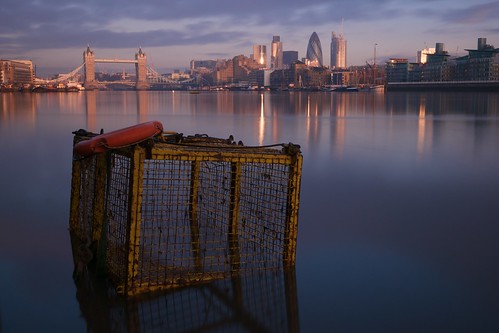
[Image - Clean up cage, Bermondsey by Tubb]
I thought I'd start with a photo by Flickr user Tubb who uploaded several cracking shots this week. I couldn't help feeling that there was something dreamlike and surreal about this shot. It's amusing that the cage steals the show from the landscape. I also like the way the low angle makes it look as though the city has been flooded...which leads us perfectly to our first link:
- When Sea Levels Attack - Neat visualisation of controversial climate-change figures produced by Information is Beautiful - The Guardian
- Oyster Ineptitude - Don't forget to Touch Out! - Londonist
- Heron Tower becomes tallest building The City - BBC
- Wanted: Hand-Drawn Maps Of London - Try your hand at DIY cartography - Londonist
God's eye views of the Olympics:
Architecture and Infrastructure:- Olympic Venues Past, Present and Future as Seen From Space - How does London compare? - Wired
- Expect the drones to swarm on Britain in time for 2012 - Anna Minton on surveillance in Stratford City for the Olympics - The Guardian
Surveillance (near enough unbelievable what's been reported this week):
- Britons are fearing for their rights - Henry Porter on the state's "surveillance culture" - The Guardian
- Photographer films his own 'anti-terror' arrest - Accrington Police and PCSOs successfully arrest an innocent man - The Guardian [via Notes from the Ubiquitous Surveillance Society]
- Mall bans father from photographing son - ...just in case of course? How long 'til family photo albums are considered suspect I wonder? - BBC
- Video of Police using terror legislation to stop ex-RAF engineer in Kidlington town centre - Because you can't be too careful (?) - Oxford Mail [via Big Brother Watch]
- Take Back the Streets 1 - In 2003 Seoul in South Korea demolished a freeway in order to revive an ancient stream through the heart of the city - Landscape+Urbanism
- US Ambassador is spoiling our view of the Thames - Jonathan Glancey describes the winning design as "Cool, remote and superficially transparent"- The Guardian
- US Embassy Exhibition - Showing us what we could've won - Londonist
- Learning curve: Sanaa's spectacular floating Lausanne library - Report on the Japanese firm's undulating glass and concrete Rolex Learning Centre - The Independent
- EPFL Rolex Learning Centre - Japanese architects Kazuo Sejima and Ryue Nishizawa (aka Sanaa) explain its curved concrete and glass structure: "with curves we can create more diverse interactions" - via Archinect
- Kim Høltermand - Awe inspiring photography in the second instalment of this new series of interviews with architectural photographers - Archinect
- Urban Legends - Writing and street photography by The Flaneurbanite, a fellow explorer of the Metropolis - via Londonist
- Sodom & Gomorrah - Infamous biblical cities re-envisioned as an "amusement park for visionaries" by Italian artist Alessandro Bavari - via WebUrbanist
- Plans to cut off internet connections of illegal filesharers dumped - The Guardian
- My bright idea - Video of Jaron Lanier, author of You are Not a Gadget: A Manifesto, discussing the concept of "Digital Maoism" - The Observer
- Jump Magazine Issue 1 - First issue of Jump parkour magazine viewable online or as a (Free) pdf download - Urban Freeflow
- Subversive Street Signs - The art of misdirection - Urban Prankster
- Crawler Town - A hulking, steam-punk inspired, mobile city created from Lego by Dave DeGobbie - Flickr [via Boing Boing]
- Flying into the future - A company in New Zealand are banking on a future for personal jetpacks - Telegraph
- Papierkrieg - An impressive short film with an age old theme "My ............ is better than yours!" - Vimeo
- UK Truck Simulator - Smokey without the Bandit...but nifty 3D modelling - via Digital Urban
[Video - UK Truck Simulator official game trailer by SCS Software on YouTube]
I hope you enjoyed the links. Please let me know if you have any comments. Many thanks to Flickr user Tubb for licensing use of their photography with Creative Commons.





